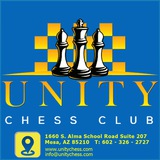Black decides to allow doubled f-pawns. 13...Be7 can be met by 14.Rd2 (after 13.e3 this would not have been possible) .
Now with his damaged pawn structure Black should have looked for dynamic counterplay with, for example, 16...a5 .
Although d5 is not a passed pawn, d6 will be an excellent post for the knight.
from here the white pawns on c4 and e4 are attacked, while the knight also supports the flank attacks ...b5 and ...f5.
Unity Chess Club
Alexander Rakhmanov-Alexander Shimanov Minsk 2014 Black to move
In this symmetrical position, Black is slightly more active for the moment. With his next move, he tried to gain some space.
Not the only move, but a good example that shows how a knight can dominate from the edge. After Black's next the a1- bishop is not the stronger piece.
Putting all White's pieces on the back rank! This move underlines the strength of the a4-knight, which also hampers the natural development of White's knight to c3.
And having eliminated the (powerful! ) a4-knight White held the draw.
Now the diagonals of both white bishops will be opened. Anand is facing his own twin gun!
